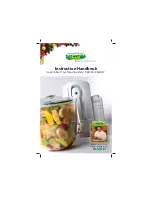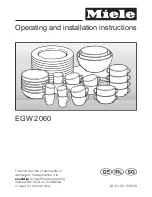
157
156
GB
GB
■
THE CONTAINER WILL NOT VACUUM
1. Make sure that the extraction hose is firmly connected to the vacuum opening
as well as the container lid and push the connection pieces into the openings as
far as possible.
2. Press down on the lid
or
the hose connection to ensure that the container is
airtight.
3. If the container or the adaptor is visibly damaged, change the container or
adaptor. Make sure that the container lid is tight all around.
4.
If fluid leaks from the container during vacuuming, the container and it’s con-
tents should first be cooled in the fridge.
5. Check the functioning of the appliance.
6. Check that the edge of the container and the lid are completely dry and that
there is 3 cm distance between the food and the top edge of the container.
If none of these suggestions apply, please contact Solis or a Solis approved service
station.
■
THE HEXAGONAL CONTAINER IS NOT MAINTAINING
A VACUUM
1. Check that the control dial is at the
“SEAL”
position, before, during and after
vacuuming.
2. Check that the rubber seal is sitting correctly and is undamaged.
■
THE SQUARE CONTAINER IS NOT MAINTAINING
A VACUUM
Check that the rubber seal is sitting correctly and is undamaged.
■
THE APPLIANCE DOES NOT SEAL
AFTER VACUUMING
1. There is a vacuum pressure sensor inside the appliance. If this pressure is not
high enough, the sealing process is not automatically started and the appliance
switches off after approx. one minute. Check the vacuum bag for leaks resp.
the weld for contamination. Also ensure correct positioning and re-start the
appliance.
2. Check whether the bag has a hole in it. To do this, seal the bag with some air
in it and submerge it in water. If bubbles rise from it, it is leaking, use another
bag.
3. Perhaps the bag is not completely sealed, because of crumbs, fat or liquid in the
seal or the bag was not flat and has wrinkles or creases. Open the bag, clean
the inside of the bag end and make sure to insert the bag end absolutely evenly
and all the way to the end stop resp. approx. 4 cm deep into the vacuum bay.
■
AIR GOES BACK INTO THE BAG
AFTER IT HAS BEEN SEALED
1. Perhaps the bag is not completely sealed, because of crumbs, fat or liquid in the
seal or the bag was not flat and has wrinkles or creases. Open the bag, clean
the inside of the bag end and make sure to insert the bag end absolutely evenly
and all the way to the end stop resp. approx. 4 cm deep into the vacuum bay.
2. Some foods produce natural gasses or ferment, such as e.g. fresh fruit and veg-
etables. If you suspect this to be the case, open the bag and check the food. If
it is fermenting, throw the bag away. Temperature fluctuations in refrigerators
can also spoil vacuum packed foods. If in doubt, always throw the food away.
3. Check if the bag has a hole which has let air in. Sharp edges of foods should be
covered or ”padded“ with folded kitchen paper, so that the edges cannot cause
holes.
■
THE BAG BOILS OR DOES NOT SEAL PROPERLY
Should the sealing bar overheat, the bag can melt. In this case, unplug the appli-
ance and allow these parts to cool for a few minutes. As a basic principle, always
keep a 1 minute pause between two vacuuming processes.
















































